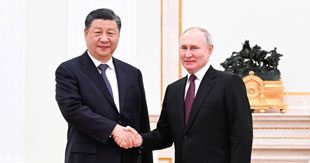
By Joe Powell & John Njoroge
I understand that Green Futures is going to assist us in the city (Kampala) by providing one of their high-tech monitoring cameras in different strategic areas so we can see who may be misbehaving and causing trouble. Thank you for bringing these surveillance skills to Uganda.
With these words, Vice-President Gilbert Bukenya, who was chief guest at the launch of Green Futures, left the prepared script thanking the company for their work on the fibre-optic network and indicated the first expansion to the Ugandan CCTV network since the Commonwealth Heads of Government Meeting (CHOGM) in 2007. Green Futures is in Uganda providing security along the fibre-optic cable line.
In addition, it says it will plant five million trees along the fibre-optic line.
Since the CHOGM, the functional ability and reliability of the close-circuit television (CCTV) technology in Kampala has been in question. According to a source working inside the CCTV command centre, who, because of the nature of his work did not want to be mentioned, none of them were adequately trained for the job they are doing.

We sit and just watch for anything suspicious to our eyes. You know the police; we don’t have enough manpower and money. Even if we identify a criminal, we can’t respond instantly. Our officers are all over but our presence is not felt due to our small number. We only try to identify the person and hope that when we land on him the next time, we pin him on the crimes he did before,†he said.
Efforts to gain access to the CCTV command centre and the CCTV team for a one-on-one interview were fruitless. The Independent was told to write a letter to the Inspector General of Police Major General Kale Kayihura, who we were told is the only official who could give authorisation access. The letter and several telephone calls to the IGP’s secretary failed to yield any fruit.
One would expect a hive of activity but according to reliable inside information, this is not always the case. The command centre is said to be a boring place to work. It has 20 monitors but only 8 are functional, while the rest lie dormant. The officers working at the centre spend most of their time watching normal Ugandan television stations, not only to stay informed but also to keep themselves occupied and awake. Morale is said to be rock bottom.
This Shs 4 billion system was sold to the Ugandan public during the build up to the 2007 CHOGM as a vital modern weapon in the fight against crime.

However, the 50-camera CCTV operation in Uganda is in fact riddled with technical faults and shocking gaps in human capacity. At Buganda Road Court, “there has not been a single case in which camera footage has been used to prosecute,†according to State Attorney David Lukwago. He noted that he has not seen a single mention of CCTV footage in a police report and expressed his surprise at the failure to do so.
Lukwago went on to say “if at Buganda Road there is nothing then it is very unlikely to be at other courts as most of the cameras are in our jurisdictionâ€. “It’s not been of any help…even in traffic cases,†he concluded.
Bruce Kyerere, chairman of the Uganda Law Society concurred, saying that “I cannot recall any case where such a thing [CCTV evidence] has been used in courtâ€.
A senior police strategist confirmed to The Independent that problems with the system are multiple. “First the positions of the cameras are not best suited to catching criminal behaviour,†he said. “They tend to be located in traffic hotspots such as by the Clock Tower, on Entebbe Road and by the Taxi Park but are scarce, for example, in Kampala’s teeming markets where pickpockets are known to target.â€

Second the connection on MTN is fuzzy and often drops off, meaning that until fibre optic cable is laid to each camera there is no guarantee that footage can be relayed back to Police HQ. A third problem pointed out by our source is that many of the cameras do not have infra-red capability, meaning that only those positioned in well lit areas are useful at night.
A separate senior officer pointed out a further flaw in the system in that footage from the cameras is only kept for a maximum of three months due to storage constraints. This means detectives are unable to rely on CCTV when investigating crimes that come to light after that period.
The reaction from the Secretary for Security of the Kampala City Trader’s Association (KACITA) is similarly damning. Jemba Mulondo said that “Uganda Police have never shown us any results†despite the fact that it was business leaders who originally came up with the idea in the wake of the 2005 riots on Kizza Besigye’s return.
Indeed the business community offered to cover half the costs of the project but were rebuffed by the police. Without the involvement of those that rely on security, Mulondo believes that the cameras are now little more than “scarecrows†in the city. He gives the example of the fact that cars regularly create extra lanes in Kampala right under the nose of cameras such as that at Clock Tower.
For Mulondo the problems started right at the tendering process, during which 11 companies bid for the contract of putting up the CCTV for CHOGM. According to senior private security sources only two companies had done proper mapping and site surveys for the proposed cameras. In the event Sekanyolya Systems won the Shs 4 billion contract to install 50 cameras around Kampala and Entebbe, despite not having submitted a detailed site plan. This was after the tendering process was taken over by the Internal Security Office. Indeed security sources allege that fears over corruption in the tendering process led to the resignation of spy chief Juventine Odoket, who headed police’s Special Branch.
The tendering process was further marred when a company called IBC was thrown out of the race for having no valid address and a fabricated track record. In a letter seen by The Independent dated August 2, 2006 the chairman of the KACITA expresses these concerns and urges Odoket to “get the actual people behind†the company. Eventually pressure from business leaders and other bidders forced IBC out of the process.
More weaknesses were found in the specifications for the tender, especially concerning the method of transmitting footage from the cameras to the control room. Edwin Kinyanjui, a expert in CCTV systems based in Nairobi, said that “the tender did not specify how data would be transmittedâ€, the implication being that the government should have insisted on fibre-optic transmission to cut down on network problems when using micro-waves.
Although the police refused to speak to The Independent on the record Yasin Matovu, Security Manager for Sekanyolya, did agree to talk. He claimed it was understandable the police did not “publicise when they arrest someone†from the CCTV due to security reasons. Matovu went on to blame the “ignorance of the public†and the law for the failings in the system. Ssekanyolya marketing manager Livingstone Seruyange said that the fact that there is “no red light flashing on the cameras†means people believe the system is not working.
The CEO of Green Futures, Fred Sewe, spoke to The Independent following the launch and confirmed that the vice-president was talking about new 360-degree infra-red cameras that would be maintained by his firm. He was quick to stress, however, that it was the police’s job to monitor the system and that Green Futures was “not a security companyâ€. According to Sewe, the cameras would be used “according to what somebody wants†but that traffic monitoring would be the primary focus.
Patrick Tumwine of Human Rights Network Uganda voiced separate concerns over the potential for invasion of privacy. “I don’t think they have enough capacity or enough training so there is a fear of abusing and misusing [the cameras]†he told The Independent, “As citizens we have the right to receive security without invasion of privacyâ€. He also linked the CCTV network to the phone-tapping bill that is currently back before the ICT committee, suggesting that the government is too keen on surveillance without the necessary checks and balances.
 The Independent Uganda: You get the Truth we Pay the Price
The Independent Uganda: You get the Truth we Pay the Price


